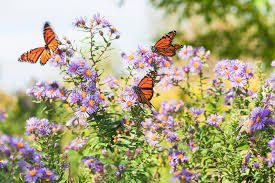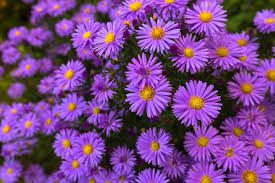Nature has gifted us with a mesmerizing array of flowers, each with its unique charm and beauty. Among these floral treasures, the Aster flower stands out as a true delight for the senses. With its captivating colors and intricate petals, the Aster has captured the hearts of flower enthusiasts and gardeners alike.
Scientifically known as Asteraceae, this enchanting flower boasts a rich history, diverse symbolism, and a fascinating range of varieties.
The Aster flower belongs to the family Asteraceae, which encompasses an extensive group of flowering plants. This family, also referred to as the daisy family, is characterized by composite flowers composed of multiple florets arranged in a captivating symmetrical pattern.
Asters, with their daisy-like appearance, reflect this characteristic, showcasing a beautiful composition of numerous tiny flowers clustered together to form a single bloom.
One of the most remarkable aspects of the aster flower is its astounding diversity. With over 600 species found across various regions of the world, asters present an endless palette of colors and shapes. These radiant blooms come in shades of vibrant purple, soft lavender, cheerful pink, sunny yellow, and pristine white, among others. Their charming hues instantly add a touch of elegance and vibrancy to any garden or floral arrangement.
Asters are renowned for their distinctive star-shaped petals, which contribute to their name, derived from the Greek word “aster,” meaning star. Each petal gracefully tapers to a point, creating a captivating star-like appearance.
This unique structure not only adds to their visual appeal but also serves as an invitation to pollinators, as it provides a convenient landing platform for bees, butterflies, and other beneficial insects.
Beyond their aesthetic allure, asters have acquired a rich tapestry of symbolism and meanings throughout history. In many cultures, these flowers are associated with enchantment, patience, and daintiness.
They are often regarded as symbols of love and affection, making them a popular choice for gift bouquets and expressions of admiration. In some folklore, asters are even believed to possess magical properties, bringing good luck and warding off evil spirits.
In addition to their cultural significance, asters also hold a prominent place in the realm of gardening and horticulture. These resilient flowers bloom late in the summer, injecting a burst of color into gardens that might be winding down for the season.
Their ability to thrive in a variety of climates and soil conditions, coupled with their long-lasting nature, makes asters a favorite among gardeners seeking reliable and beautiful blooms.
Gardeners can choose from an assortment of aster species, each with its unique growth habits and characteristics. Some popular varieties include the New England aster (Symphyotrichum novae-angliae), with its vibrant purple flowers and bushy growth; the Michaelmas daisy (Symphyotrichum novi-belgii), displaying delicate blue, pink, or white blooms; and the China aster (Callistephus chinensis), boasting a wide spectrum of hues and a more compact growth habit.
Whether used in stunning floral arrangements, cultivated in gardens, or simply admired in their natural habitats, aster flowers never fail to leave a lasting impression. Their botanical name, Asteraceae, serves as a testament to their star-like allure and their ability to shine brightly among the floral constellations. So, next time you encounter these delightful blossoms, take a moment to appreciate the intricate beauty and captivating charm of the aster flower, nature’s exquisite gift to our senses.
Read Also: Are Snakes Good or Bad and What Do Snakes Eat? Find Out
Complete Growing Guide of the Aster Flowers

Asters are beautiful flowering plants that can add vibrant colors and a touch of elegance to your garden. Whether you are a seasoned gardener or a beginner, here is a complete growing guide to help you cultivate and care for aster flowers:
1. Selecting the Right Variety: Asters come in various species and cultivars, each with its unique growth habit and flower characteristics. Consider factors such as bloom color, height, and hardiness when choosing the right variety for your garden. Popular choices include New England asters (Symphyotrichum novae-angliae), Michaelmas daisies (Symphyotrichum novi-belgii), and China asters (Callistephus chinensis).
2. Choosing a Suitable Location: Asters thrive in full sun, although they can tolerate partial shade. Select a location in your garden that receives at least six hours of direct sunlight daily. Ensure that the soil is well-draining, as asters prefer moist but not waterlogged conditions.
3. Soil Preparation: Prepare the soil before planting by removing weeds, rocks, and debris. Asters prefer fertile soil with a slightly acidic to neutral pH level (around 6.0 to 7.0). Improve the soil’s texture and fertility by incorporating organic matter, such as compost or well-rotted manure.
4. Planting Asters: Asters can be started from seeds or purchased as young plants from nurseries or garden centers. Follow the instructions provided on the seed packet or the nursery label for proper spacing and planting depth. Generally, asters should be spaced about 12 to 18 inches apart to allow for adequate airflow and growth.
5. Watering and Moisture: Water asters regularly, especially during dry periods, to keep the soil consistently moist but not waterlogged. Deep watering is preferable to frequent shallow watering, as it encourages the plants’ root development. Consider using a soaker hose or drip irrigation system to ensure the water reaches the roots directly.
6. Mulching: Apply a layer of organic mulch around the base of the plants to help conserve moisture, suppress weed growth, and regulate soil temperature. Mulch also adds nutrients to the soil as it breaks down over time. Use materials like straw, shredded bark, or compost, and keep the mulch a few inches away from the stems to prevent rotting.
7. Supporting Tall Varieties: Some aster varieties can grow quite tall and may require staking or support to prevent bending or breaking. Install stakes or plant supports early in the growing season to provide stability. Gently tie the stems to the support using soft twine or plant ties, being careful not to constrict the growth.
8. Deadheading and Pruning: To encourage continuous blooming and maintain a tidy appearance, remove faded flowers by deadheading. Pinch or snip off the spent flowers just above a set of healthy leaves or buds. Additionally, in late spring or early summer, you can pinch back the plants’ top growth by a few inches to encourage bushier growth and more abundant blooms.
9. Pest and Disease Management: Asters are generally resilient plants, but they can be susceptible to some pests and diseases. Monitor your plants regularly for common issues such as aphids, powdery mildew, or leaf spot. If necessary, use organic pest control methods or consult with your local garden center for suitable remedies.
10. Overwintering: Asters are perennial plants in many regions and can survive winter with proper care. As fall approaches, stop fertilizing the plants to allow them to gradually prepare for dormancy. Mulch around the base of the plants with a layer of straw or shredded leaves to insulate the soil and protect the roots from extreme cold. In colder climates, you can cover the plants with a layer of burlap or frost cloth for added protection.
By following these guidelines, you can successfully grow and enjoy the beauty of aster flowers in your garden. With their captivating colors, star-like petals, and diverse varieties, asters will undoubtedly become a cherished addition to your outdoor space, attracting pollinators and bringing joy to both you and your visitors.
Read Also: Wild Snake: Description, Health and Nutrition
Uses of the Aster Flowers

Aster flowers have a variety of uses beyond their aesthetic appeal. Here are some common uses of asters:
1. Ornamental Purposes: Asters are primarily grown for their ornamental value. These charming flowers add a burst of color and beauty to gardens, landscapes, and floral arrangements. Their vibrant blooms and star-shaped petals make them popular choices for cut flower arrangements, bouquets, and flowerbed borders.
2. Pollinator Attraction: Asters are known for their ability to attract pollinators, such as bees, butterflies, and hoverflies. The nectar-rich flowers serve as valuable food sources for these beneficial insects, supporting pollination and contributing to the overall health of ecosystems. By planting asters in your garden, you can create a welcoming habitat for pollinators and encourage biodiversity.
3. Wildlife Gardens: Asters play a role in creating wildlife-friendly gardens. Beyond attracting pollinators, they can also provide shelter and food for various wildlife species. The dense foliage of certain aster varieties offers nesting sites for birds, while the seeds of spent flowers can serve as a food source for birds and small mammals during the colder months.
4. Medicinal Uses: Some species of asters have a history of medicinal use. For example, the New England aster (Symphyotrichum novae-angliae) has been traditionally used by Native Americans for its medicinal properties. The plant’s roots were used in herbal remedies to treat ailments such as respiratory issues, fevers, and digestive disorders. However, it’s important to note that the use of asters for medicinal purposes should be approached with caution and under the guidance of a knowledgeable herbalist or healthcare professional.
5. Dyeing: The petals of certain aster species can be used for natural dyeing purposes. Asters with vibrant colors, such as purple or pink, can yield beautiful dyes for fabric or yarn. The process typically involves simmering the petals in water to extract the dye, which can then be used to create unique and eco-friendly hues.
6. Symbolic Meanings: Asters hold symbolic meanings in different cultures and traditions. They are often associated with love, patience, elegance, and enchantment. A bouquet of asters can be a thoughtful gift to express affection or admiration. Additionally, asters are sometimes used in floral arrangements for special occasions, such as weddings or anniversaries, as they convey messages of long-lasting love and devotion.
While asters are primarily cultivated for their decorative value, their role in supporting pollinators, contributing to wildlife habitats, and their historical significance in herbal medicine and symbolism further enhance their value and appeal.
Whether you enjoy asters for their visual splendor or appreciate their broader contributions to nature, these versatile flowers have an enduring charm that transcends mere ornamentation.
Read Also: Benefits of Infant Cereal





